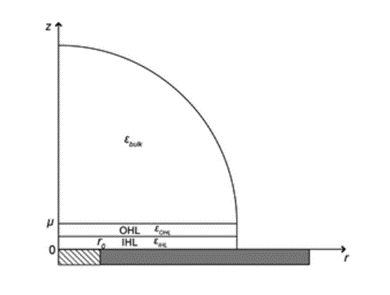Considering that an electric-double-layer (EDL) structure may significantly impact on the mass transport and charge transfer kinetics at the interfaces of nanometer-sized electrodes, while EDL structures could be altered by the finite sizes of electrolyte and redox ions, the possible effects of ion sizes on EDL structures and voltammetric responses of nanometer-sized disk (nanodisk) electrodes are investigated. Modified Boltzmann and Nernst–Planck (NP) equations, which include the influence of the finite ion volumes, are combined with the Poisson equation and modified Butler–Volmer equation to gain knowledge on how the finite sizes of ions and the nanometer sizes of electrodes may couple with each other to affect the structures and reactivities of a nanoscale electrochemical interface. Two typical ion radii, 0.38 nm and 0.68 nm, which could represent the sizes of the commonly used aqueous electrolyte ions (e.g., the solvated K+) and the organic electrolyte ions (e.g., the solvated TEA+) respectively, are considered. The finite size of ions can result in decreased screening of electrode charges, therefore magnifying EDL effects on the ion transport and the electron transfer at electrochemical interfaces. This finite size effect of ions becomes more pronounced for larger ions and at smaller electrodes as the electrode radii is larger than 10 nm. For electrodes with radii smaller than 10 nm, however, the ion size effect may be less pronounced with decreasing the electrode size. This can be explained in terms of the increased edge effect of disk electrodes at nanometer scales, which could relax the ion crowding at/near the outer Helmholtz plane. The conditions and situations under which the ion sizes may have a significant effect on the voltammetry of electrodes are discussed.
https://doi.org/10.1039/C6FD00087H
